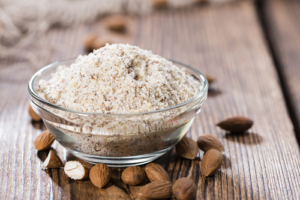 Sometimes, food grinding can’t be a “one and done” process. When it comes to size reduction, the laws of physics dictate that you can only do so much work in a single pass.
A classic example is in the reduction of a twenty-pound wheel of parmesan cheese.
Say you need to grate this large wheel of cheese for pizza topping. Pizza topping requires a nice, fine grind with no chunks or large clumps of product. If you try to reduce the entire wheel in a single pass, though, you’ll end up with one of two outcomes: you’ll either overheat your material or destroy your machine.
Instead, begin by reducing the wheel of cheese into small pieces via an initial grinding pass – chunks of 0.75”, for example. Once you’ve made a single pass and reduced the material to 0.75”, you can take this output and grind it once again, through a different machine, to create a smaller particle size. This is called double pass grinding. While double pass grinding is common in commercial uses, it’s also utilized by at-home chefs grinding meats and other products.
The process of double pass grinding is essential for a few reasons. The first and most obvious is that it reduces the load on both machines during passes. The amount of load it takes to process a large product directly into its final form factor can be massive. For example, the rotating imbalance of flinging around a 20 pound block of material is enormous and potentially damaging. The objective for companies is to get the material through the mill as quickly as possible without negatively impacting the product or the machinery. Double pass grinding can greatly increase the efficiency of the size reduction operation. This consideration is especially critical for a product which will melt under high heat loads.
Sometimes, food grinding can’t be a “one and done” process. When it comes to size reduction, the laws of physics dictate that you can only do so much work in a single pass.
A classic example is in the reduction of a twenty-pound wheel of parmesan cheese.
Say you need to grate this large wheel of cheese for pizza topping. Pizza topping requires a nice, fine grind with no chunks or large clumps of product. If you try to reduce the entire wheel in a single pass, though, you’ll end up with one of two outcomes: you’ll either overheat your material or destroy your machine.
Instead, begin by reducing the wheel of cheese into small pieces via an initial grinding pass – chunks of 0.75”, for example. Once you’ve made a single pass and reduced the material to 0.75”, you can take this output and grind it once again, through a different machine, to create a smaller particle size. This is called double pass grinding. While double pass grinding is common in commercial uses, it’s also utilized by at-home chefs grinding meats and other products.
The process of double pass grinding is essential for a few reasons. The first and most obvious is that it reduces the load on both machines during passes. The amount of load it takes to process a large product directly into its final form factor can be massive. For example, the rotating imbalance of flinging around a 20 pound block of material is enormous and potentially damaging. The objective for companies is to get the material through the mill as quickly as possible without negatively impacting the product or the machinery. Double pass grinding can greatly increase the efficiency of the size reduction operation. This consideration is especially critical for a product which will melt under high heat loads.
55-gallon drums are a convenient way to acquire frozen product, but can be a pain in the neck to deal with. Not only are these drums large and unwieldy to move around, but they take a long time to thaw. At most plants, food processing companies deal with this problem by leaving drums of material outdoors to thaw.
The big issues with that solution are that they don’t let them thaw out long enough and the center remains frozen. Alternatively, companies let them soften too long, risking spoilage. If you have a frozen kernel in the middle of the drum, the core will mostly be water.
Orange juice concentrate is a great example: the water freezes before the sugar, so you wind up with a frozen drum of juice that’s mostly sugar on the outside with a hard kernel of ice in the middle. To transform it back to orange juice, you then have to break up the ice ball, add water, and mix.
Introducing size reduction equipment not only dramatically speeds up the thawing process, but also prevents damage from under-thawed material in downstream processes.
 The easiest way to deal with these large drums of material is to conduct the entire process while the material is still frozen. Unfortunately, there’s not much equipment out there that can do it. Most rotary chippers designed for this are ineffective and slow. Other pieces of equipment, like the Reitz Extractor, for example, serve different purposes. The Extractor is a large, stainless steel, high-capacity, meat grinder. While the machinery is robust, it is too expensive or unsanitary for many companies.
The easiest way to deal with these large drums of material is to conduct the entire process while the material is still frozen. Unfortunately, there’s not much equipment out there that can do it. Most rotary chippers designed for this are ineffective and slow. Other pieces of equipment, like the Reitz Extractor, for example, serve different purposes. The Extractor is a large, stainless steel, high-capacity, meat grinder. While the machinery is robust, it is too expensive or unsanitary for many companies.
Because of that, some companies use Crushers, which is what we manufacture here at Corenco. Crushers are a less costly method of processing large amounts of frozen material, from 5-gallon buckets to 55-gallon drums. Thaw 55-gallon Drums of Frozen Product – These Crushers reduce content down to softball-sized or smaller chunks. Many companies utilize a subsequent milling step to further reduce their material to a “snowcone,” or a pumpable, slurry.
Size reduction improves the efficiency and productive capacity of processing lines that involve large bulk/frozen products. Corenco’s Crushers can be found all over the world tirelessly performing size reduction with minimal upkeep and maintenance. Our technology helps streamline the thawing process and ensures faster processing times for our customers, and Crushers by Corenco will go a long way to improve and enhance your product thawing efforts. If you’re interested in investing in machinery that could streamline your thawing or bulk product size reduction process, contact Corenco today. We manufacture many lines of durable, reliable size-reduction equipment meant for a wide variety of applications. We’re happy to help you navigate our selection and find the products that are perfect for you.